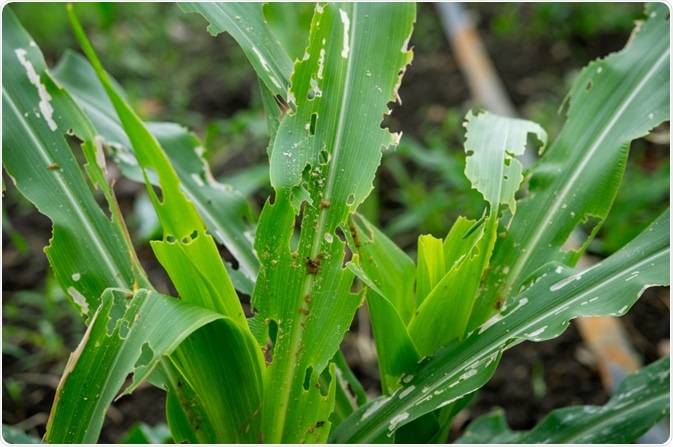With a rapidly growing world population, the reliance on crops is rising in conjunction. Maintaining food security is a considerable challenge in a world-changing at such a fast pace, with environmental alterations threatening the availability, quality, and sustainability of crop systems. In addition to abiotic challenges, the resilience of key crops is susceptible to the prevalence of pests and pathogens.

Image Credit: RachenStocker/Shutterstock.com
Pests and pathogens threaten food security by consuming or degrading crops but can also indirectly reduce water quality, increase soil erosion, and compete against native species, generating long-lasting changes.
The impacts of pests and pathogens are recognized to vary across agroecosystems, but their effects are particularly exacerbated in regions lacking the capacity to prevent, manage or recover from the damage incurred, which often correlates with socioeconomic status.
Moreover, global agricultural systems depend on a limited number of crops with little diversity in species and variants, potentially increasing the risk of crop losses due to such specialization. For instance, wheat and rice alone represented 18.3 and 18.9% respectively of the world’s human calorie intake in 2013.
Identifying areas and crop systems susceptible to the impacts of pests and pathogens is a fundamental issue for policymakers, particularly in such a rapidly changing world.
Understanding how pests and pathogens affect crops
To better understand how pests and pathogens affect different crops around the world, an international team including Serge Savary from the Université de Toulouse and Andy Nelson from the University of Twente in the Netherlands, offered a new global perspective on this emerging issue.
The study used online surveys and collected 989 responses from experts located across 67 of the primary hot spots of food production around the world. The surveys focused on the pests and pathogens affecting wheat, rice, maize, potato, and soybean, and identified a total of 137 of the most damaging pests and pathogens.
The yield loss estimates per crop per hotspot ranged from the lowest of 17.2% loss for the potato to the highest of 30% for rice. The range within these yield losses also shows considerable variations across hot spots and crop types. Additionally, the highest losses were associated with regions of food-deficit characterized by fast-growing populations, further indicating the disparity in the effects of pests and pathogens across regions.
To further supplement the overarching effects of crop losses, the majority of responses identified in the survey also indicated that crop losses were ‘chronic’, which was defined as an effect occurring every growing season.
The documented impacts in regions experiencing frequent food-deficit are therefore particularly significant as the chronic emergence of pests exacerbates crop losses. Accordingly, this study provides a basis for policy prioritization to investigate key regions, crop systems, and pest species to identify features most vulnerable to crop losses.
Specifically, examples of major drivers of crop losses are pests such as the fall armyworm for maize or sheath blight caused by the highly infectious fungus Rhizoctonia solani in rice. Some pests can also be found across different crop systems including the cyst nematodes, which drive extensive losses in soybean and potato.
Identifying the most common pests across crop types is a key finding in this study and provides a basis for pest control in specific regions that are most affected. Other solutions discussed in this study also focuses on crop varietal resistance, management, and improving host resistance.
However, the findings of this study corroborated with previous results on global crop losses from research over 20 years ago, suggesting that the effects of these pests remain persistent despite such a rapidly changing world.
In addition to well-documented challenges, novel species of pests and pathogens, as well as re-emerging species currently threatening crop systems, may threaten food security in key regions. Emergent species, in particular, may represent a challenge more difficult to overcome for plant defenses, particularly in an increasingly connected world, as crops have not evolved any defenses to counteract its impacts.
Interestingly, the current study also examined how responses differed across climate, pointing towards a range of responses associated with environment type. This may be of key interest when considering impacts of global change, as the range, abundance, and diversity of crops may be further affected.
The perspective provided by this study is central to establishing long-term policy objectives as well as policy priorities, which can be further improved with experimental data and field observations.
Conclusion
Further efforts may be able to compile similar data to quantify the effects of crop losses into the future, estimating potential crop losses and determining which pests and pathogens may be of greater threat.
The advent of global change, as well as other factors associated with human activity, will likely generate new species of pests as well as change the occurrence of current species, thus representing a considerable challenge in future agricultural systems.
Sources:
- Savary, S. et al. (2019) ‘The global burden of pathogens and pests on major food crops’, Nature Ecology & Evolution, 3(3), pp. 430–439. doi: 10.1038/s41559-018-0793-y.
- FAO STAT (Food and Agriculture Organization of the United Nations, 2018)
- Oerke, E.-C. (1999) ‘CHAPTER 3 - Estimated crop losses due to pathogens, animal pests and weeds’, in OERKE, E.-C. et al. (eds). Amsterdam: Elsevier, pp. 72–741. doi: doi.org/10.1016/B978-0-444-82095-2.50009-9.
Further Reading